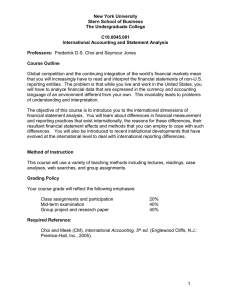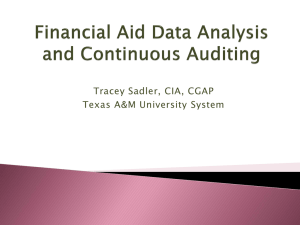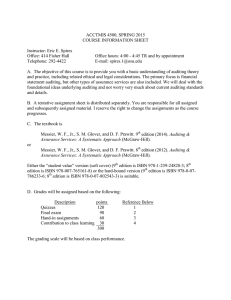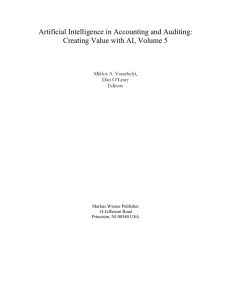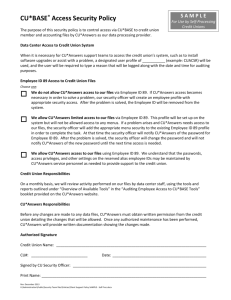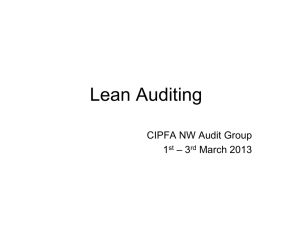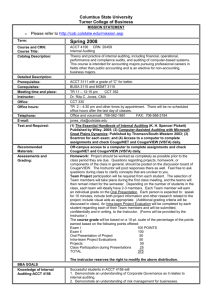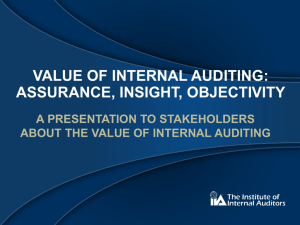International Accounting Diversity
advertisement
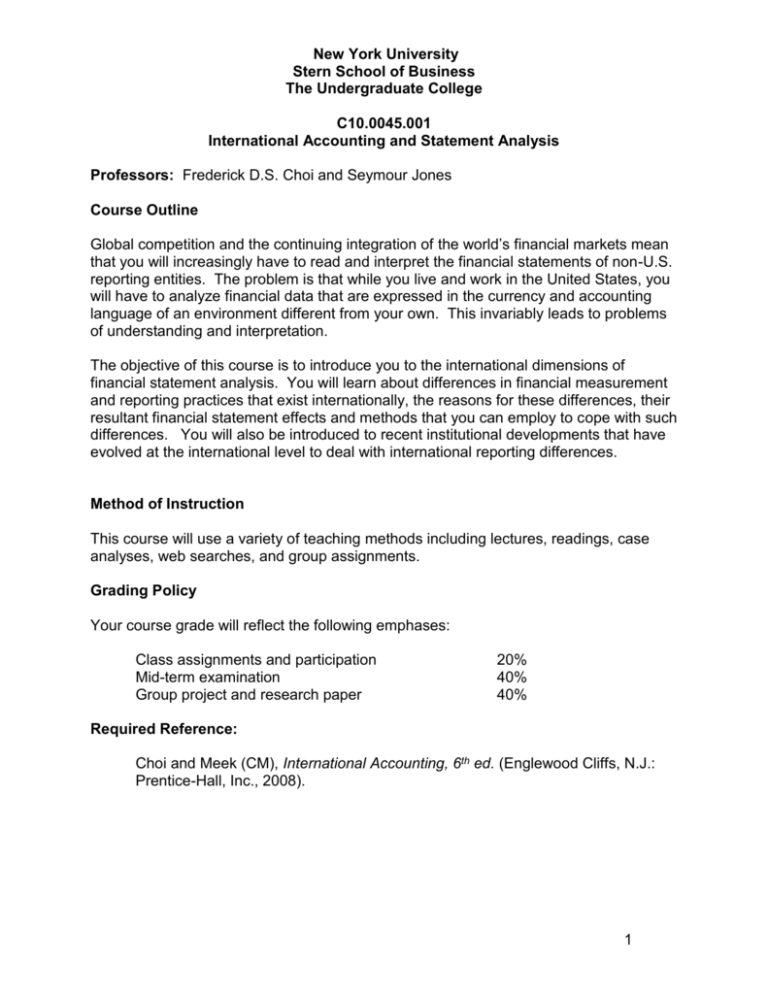
New York University Stern School of Business The Undergraduate College C10.0045.001 International Accounting and Statement Analysis Professors: Frederick D.S. Choi and Seymour Jones Course Outline Global competition and the continuing integration of the world’s financial markets mean that you will increasingly have to read and interpret the financial statements of non-U.S. reporting entities. The problem is that while you live and work in the United States, you will have to analyze financial data that are expressed in the currency and accounting language of an environment different from your own. This invariably leads to problems of understanding and interpretation. The objective of this course is to introduce you to the international dimensions of financial statement analysis. You will learn about differences in financial measurement and reporting practices that exist internationally, the reasons for these differences, their resultant financial statement effects and methods that you can employ to cope with such differences. You will also be introduced to recent institutional developments that have evolved at the international level to deal with international reporting differences. Method of Instruction This course will use a variety of teaching methods including lectures, readings, case analyses, web searches, and group assignments. Grading Policy Your course grade will reflect the following emphases: Class assignments and participation Mid-term examination Group project and research paper 20% 40% 40% Required Reference: Choi and Meek (CM), International Accounting, 6th ed. (Englewood Cliffs, N.J.: Prentice-Hall, Inc., 2008). 1 International Accounting and Statement Analysis Topical Outline January February 22 T International Accounting Diversity What is international accounting? Why is it important? What are the basic issues? What are some methods for coping with accounting and corporate reporting differences? Read: CM, Ch. 1. 24 Th Accounting Diversity—continued Prepare: Q1.11, Q1.12, E1.10, and Case 1-2 Global Benchmarks: Infosys Technologies Limited 29 T 31 Th 5 T 7 Th 12 T Accounting Development Patterns What accounts for national variations in observed accounting and reporting practices? Are accounting practices uniformly different in all countries? Are there any recognizable reporting patterns? Read: CM, Ch. 2. Developmental Patterns—continued Prepare: Case 9-1 Sandvik Comparative Accounting I What are some distinctive reporting practices in Europe? Read: CM, Ch. 3. Prepare: Case 9-2: Continental A.G. Comparative Accounting II Financial reporting in emerging markets and the phenomenon changing prices. Read: CM, Ch. 7. Prepare: E7.2, E7.3, E7.4. Case Analysis: Case 7-1: Icelandic Enterprises Country/Company selections due! 14 Th Accounting for Foreign Exchange Rate Changes Nature and purpose of foreign currency translation. Transaction versus translation gains and losses. Various translation methods used by MNC’s. Read: CM, Ch. 6. 19 T FX Accounting—continued Prepare: E6.5 E6.6, E6.7, E6.8. 21 Th Case 6-1 Regents Corporation 26 T 28 Th FX Accounting and Analysis of Foreign Operations Prepare: Case 10-1 Foreign Investment Analysis: A Tangled Affair Pensions Pension accounting has proven controversial given the sensitivity of pension expense to various assumptions and gaming schemes. John Biggs, Stern Executive-in-Residence and former Chairman and CEO of TIAA-CREF, will share his experience, as well as provide an international perspective, on the subject. 2 March 4 T 6 Th Wrap-up 11 13 T Th Mid-term Exam International Accounting Harmonization Read: CFM, Ch. 8. 17-21 April May International Ratio Analysis Read: CM, Ch. 9(Appendixes 9-1, 9-2). Prepare: Case: Toyoza vs. Lincoln Enterprizes (class handout) Spring Recess 25 T Accounting Harmonization-continued Prepare: Case 8-1 “Sinopec Shanghai Petrochemical Company Ltd.,” (pp. 314). 27 Th International Auditing Issues Read: CM, Ch. 9 (pp. 336-348). Role of auditing in evaluation of international financial statements; U.S. generally accepted auditing standards vs. statutory auditing standards; assessing credibility in light of auditing standard differences 1 T 3 Th 8 T 10 Th 15 T 17 Th International Taxation-continued Prepare: E12.3 and E12.11 22 24 29 1 T Th T Th Group Presentations Group Presentations Group presentations Group Presentations International Auditing Issues – continued International Auditing: Reconciliation of foreign accounting practices to U.S. generally accepted accounting principles in public filings with the SEC. International Auditing – continued Managerial Planning and Control What is financial control? What are features of a good multinational control system? Read: CM, Ch. 10. Prepare: Case 10-2 Assessing Foreign Subsidiary Performance in a World of Floating Exchange Rates International Taxation (Guest Speakers) Read: CM, Ch. 12 International Statement Analysis Paper Due May 7-14 Final Examinations 3 Financial Analysis Guidelines Financial statement analysis is today a well-established tool for performance evaluation, credit appraisal and security analysis. While financial ratios do not capture all variables affecting enterprise performance, they are an important basis for investor perceptions of risk and return. International ratio comparisons are subject to a number of pitfalls. When doing a time series analysis, ratio comparisons are complicated by foreign exchange rate changes and changing prices. Inter-country comparisons are also complicated by differences in national accounting principles. Even when the financial statements underlying ratio analyses have been adjusted to US GAAP, they are misinterpreted because investors do not understand a particular foreign environment that influences all financial measures in that environment. Your assignment is to select a given country, and adopting a user's perspective, 1) compare the risk and return attributes of a large manufacturer relative to those of an American counterpart. You are to make an assessment as to which you feel is the "better" company and why. It will be necessary for you to adjust for currency differences and price differences, as well as significant differences in accounting principles. Your study should probably be done on a pre-tax basis to eliminate the effects of significant differences in tax practices internationally. You should also identify environmental variables, such as differences in social/cultural, financial and legal considerations that might further account for observed profitability and risk differences. Knowledge gained with regard to such environmental differences will sharpen your ability to properly evaluate the risk and return features of foreign security investments. A suggested outline follows: I. II. III. IV. V. VI. Introduction-objective and scope of financial analysis Country analysis A. Macro-economic analysis B. Political analysis C. Market analysis Industry analysis Company specific analysis A. GAAP adjustments B. Ratio analysis C. Cash flow analysis; i.e. free cash flows Environmental (institutional) considerations (i.e., cultural, financial mores, legal, tax, etc.) that facilitate proper interpretation of company–specific analysis. Conclusion and recommendations Group study teams should meet early to select a country, an industry and a reporting entity domiciled in that country, together with a U.S. counterpart, for their financial statement analysis project. A one-page rationale for your country, industry and company choices will be due at the start of class on February 7th. 4
